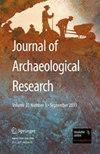中美洲前西班牙时期的天文学、建筑和景观
IF 4.1
1区 历史学
Q1 ANTHROPOLOGY
引用次数: 0
摘要
本文综述了中美洲建筑和城市规划中的天文学和世界观研究的最新进展。在这一文化区的大部分地区,市政和礼仪建筑的朝向都遵循类似的原则,但也存在地区和时间上的差异。对排列数据的分析表明,存在着独特而广泛的方位群;大多数是指特定日期的日出和日落,但也有两类与月球和金星的极值有关。与天文相关的方位经常在城市布局中占据相当大的比重。重要建筑的朝向和位置往往受到天文标准和对特定景观特征的信仰的制约;尤其值得注意的是那些与当地地平线上突出山顶对齐的建筑。根据各种背景资料,我从农业问题、宇宙学概念和政治意识形态的角度解释了方位的用途和意义。我概述了朝向做法的演变过程,提请人们注意泛中美洲趋势、地区模式和传播过程。本文章由计算机程序翻译,如有差异,请以英文原文为准。
Astronomy, Architecture, and Landscape in Prehispanic Mesoamerica
This article synthesizes recent advances in the study of astronomy and worldview in architectural and urban planning in Mesoamerica. Throughout most of this cultural area, the practice of orienting civic and ceremonial buildings followed similar principles, although regional and time-dependent variations are present. Analysis of alignment data has revealed the existence of distinct and widespread orientation groups; most refer to sunrises and sunsets on particular dates, although two groups can be related to lunar and Venus extremes. Astronomically relevant directions frequently dominate considerable parts of urban layouts. The orientation and the location of important buildings often were conditioned by astronomical criteria and beliefs about specific landscape features; particularly notable are structures that were aligned to prominent mountaintops on the local horizon. Based on a variety of contextual data, I interpret the uses and significance of orientations in terms of agricultural concerns, cosmological concepts, and political ideology. I outline the evolution of orientation practices, drawing attention to pan-Mesoamerican trends, regional patterns, and diffusion processes.
求助全文
通过发布文献求助,成功后即可免费获取论文全文。
去求助
来源期刊

Journal of Archaeological Research
Multiple-
CiteScore
10.20
自引率
7.90%
发文量
9
期刊介绍:
Journal of Archaeological Research publishes the most recent international research summaries on a broad range of topics and geographical areas. The articles are intended to present the current state-of-the-discipline in regard to a particular geographic area or specific research topic or theme. This authoritative review journal improves access to the growing body of information and literature through the publication of original critical articles, each in a 25-40 page format.2-Year Impact Factor: 4.056 (2017) 5-Year Impact Factor: 4.512 (2017)2 out of 85 on the Anthropology listIncluded in the European Reference Index for the Humanities (ERIH) PLUS The European Reference Index for the Humanities and the Social Sciences (ERIH PLUS) was created and developed by European researchers under the coordination of the Standing Committee for the Humanities (SCH) of the European Science Foundation (ESF). https://dbh.nsd.uib.no/publiseringskanaler/erihplus/about/indexSCImago Journal and Country Rank (SJR) 2018: 1.7102 out of 263 on the Archeology (Arts and Humanities) list3 out of 254 on the Archeology list2 out of 131 on the General Arts and Humanities listSJR is a measure of the journal’s relative impact in its field, based on its number of citations and number of articles per publication year.Source Normalised Impact per Paper (SNIP) 2018: 2.112The SNIP measures contextual citation impact by weighting citations based on the total number of citations in a subject field. The impact of a single citation is given higher value in subject areas where citations are less likely, and vice versa.CiteScore 2018: 3.86Rated ''A'' in the Australian Research Council Humanities and Creative Arts Journal List. For more information, visit: http://www.arc.gov.au/era/journal_list.htm
SCImago Journal and Country Rank (SJR) 2011 1.227 Archeology 1 out of 96 Archeology (Arts and Humanities) 1 out of 59 Arts and Humanities (miscellaneous) 1 out of 243
 求助内容:
求助内容: 应助结果提醒方式:
应助结果提醒方式:


